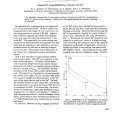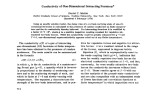TO
Filters: Format Medium: "application/pdf" Journal Title: "Physical Review Letters" Collection: "ir_uspace"
| Creator | Title | Description | Subject | Date | ||
|---|---|---|---|---|---|---|
| 1 |
 | Symko, Orest George | Adiabatic compressional cooling of He3 | By adiabatic compression of a two-phase mixture of liquid and solid He3, temperatures below 2.5 mK have been obtained. These are in the range expected for nuclear ordering in solid He3. | He3; Adiabatic compressional cooling | 1969-03 |
| 2 |
 | Vardeny, Zeev Valentine; Raikh, Mikhail E. | Anomalous coherent backscattering of light from opal photonic crystals | We studied coherent backscattering (CBS) of light from opal photonic crystals with incomplete band gaps. We observed a dramatic broadening of the CBS cone for incident angles close to the Bragg condition in the crystals. We modify the conventional CBS theory to incorporate Bragg attenuation resultin... | Coherent backscattering; Bragg condition | 2001-05 |
| 3 |
 | Vardeny, Zeev Valentine | Below-gap excitation of ∏-conjugated polymer-fullerene blends: implications for bulk organic heterojunction solar cells | We used a variety of optoelectronic techniques such as broadband fs transient and cw photomodulation spectroscopies, electroabsorption, and short-circuit photocurrent in bulk heterojunctions organic solar cells for studying the photophysics in ∏-conjugated polymer-fullerene blends with below-gap... | pi-conjugated polymers; Fullerene blends; Below-gap excitations; Bulk heterojunctions; Bulk organic heterojunction solar cells; Photophysics | 2008-07 |
| 4 |
 | Wu, Yong-Shi | Bosonization of one-dimensional exclusons and characterization of Luttinger liquids | We achieve a bosonization of one-dimensional ideal gas of particles obeying exclusion statistics A (so called A exclusons) at low temperatures, resulting in a new variant of c = 1 conformal field theory with compactified radius R = √1/λ. These ideal excluson gases exactly reproduce the low-7 crit... | Bosonization; Exclusons; Ideal gas; Luttinger liquids | 1995-07 |
| 5 |
 | Mattis, Daniel C. | Bound exciton and hole: an exactly solvable three-body model in any number of dimensions | A three-body problem, concerning two holes in a nondegenerate valence band and a single electron in a conduction band, with strong short-range interactions, is solved exactly in any number of dimensions. The binding depends nontrivially on the ratio of the valence to conduction bandwidths (i.e., on ... | Three-body problem; Trion; Bond energies | 1982-09 |
| 6 |
 | Wu, Yong-Shi | Braid group, gauge invariance, and topological order | Topological order in two-dimensional systems is studied by combining the braid group formalism with a gauge invariance analysis. We show that flux insertions (or large gauge transformations) pertinent to the toroidal topology induce automorphisms of the braid group, giving rise to a unified algebrai... | Braid group; Topological order; Zero temperature; Two-dimensional systems | 2006-07 |
| 7 |
 | Mishchenko, Eugene | Breached superfluidity via p-wave coupling | Anisotropic pairing between fermion species with different Fermi momenta opens two-dimensional areas of gapless excitations, thus producing a spatially homogeneous state with coexisting superfluid and normal fluids. This breached pairing state is stable and robust for arbitrarily small mismatch and ... | Spin-orbit coupling; Gapless excitations; Cooper instability | 2005-03 |
| 8 |
 | Mishchenko, Eugene | Charge response function and a novel plasmon mode in graphene | Polarizability of noninteracting 2D Dirac electrons has a 1 1 / √qv-ω singularity at the boundary of electron-hole excitations. The screening of this singularity by long-range electron-electron interactions is usually treated within the random phase approximation. The latter is exact only in the ... | Excitons; Random phase approximation | 2008-04 |
| 9 |
 | DeTar, Carleton | Charmed-meson decay constants in three-flavor lattice QCD | We present the first lattice QCD calculation with realistic sea quark content of the D+-meson decay constant fD+. We use the MILC Collaboration's publicly available ensembles of lattice gauge fields, which have a quark sea with two flavors (up and down) much lighter than a third (strange). We obtain... | Flavor physics; Charmed meson; Staggered fermions | 2005-09 |
| 10 |
 | Wu, Yong-Shi | Chiral bosonization and local Lorentz-invariant actions for chiral bosons | We formulate a geometrical theory of self-dual scalar fields in two dimensions with a local Lorentz-invariant action. Path-integral quantization is used to derive chiral bosonization by demonstrating equivalence of correlation functions of currents and energy-momentum tensors in our theory with thos... | Bosonization; String theory; Weyl fermions | 1988-06 |
| 11 |
 | Vardeny, Zeev Valentine; Ehrenfreund, Eitan A. | Classification of disorder and extrinsic order in polymers by resonant Raman scattering | Resonant Raman scattering is used to quantify the effect of disorder and extrinsic order on Peierls systems such as (CH)X . We introduce "X plots" in which the phonon and gap distribution are related and characterize the system by the functional dependence of the gap 2 A on the coupling X. For c/s-r... | Peierls systems | 1985-01 |
| 12 |
 | Vardeny, Zeev Valentine | Coherent phonon generation and detection by picosecond light pulses | Using the picosecond pump and probe technique we have detected oscillations of photoinduced transmission and reflection in thin films of α-As2Te3 and cis-polyacetylene. These oscillations are due to the generation and propagation of coherent acoustic phonons in the film. We discuss the generation ... | a-As2Te3; Cis-polyacetylene; Pump and probe technique | 1984-09 |
| 13 |
 | Mattis, Daniel C. | Conductivity of one-dimensional interacting fermions* | Using an exactly soluble model, the decay rate of a current-carrying state of one-dimensional fermions is calculated in the presence of random scatterers at finite temperature and the dc conductivity thereby inferred. For interacting fermions it is modified by a factor (T/T + θ)g, where g is a posi... | Fermi gas | 1974-04 |
| 14 |
 | Vardeny, Zeev Valentine | Conjugation-length dependence of spin-dependent excition formations rates in ∏-conjugated oligomers and polymers | We have measured the ratio, r =ơ s/ơT of the formation cross section, ơ of singlet and triplet excitons from polarons in ∏-conjugated oligomer and polymer films, using a spectroscopic technique we developed recently. We discovered a universal relation between r and the conjugation length (CL): ... | pi-conjugated polymers; Conjugation length; Polaron recombination | 2002-04 |
| 15 |
 | DeTar, Carleton | Continuum limit of lattice QCD with staggered quarks in the quenched approximation: a critical role for the chiral extrapolation | We calculate the light quark spectrum of lattice QCD in the quenched approximation using staggered quarks. We take the light quark mass, infinite volume, continuum limit. With nonlinear chiral extrapolations, we find that the nucleon to p mass ratio is mN/mp = 1.254 + 0.018 + 0.028, where the err... | Staggered quarks; Chiral extrapolations | 1998-10 |
| 16 |
 | Vardeny, Zeev Valentine | Cooperative emission in ∏-conjugated polymer thin films | Picosecond dynamics of exciton emission and absorption have been studied in neat thin films of a variety of poly (phenylene vinylene) derivatives. We found that the stimulated emission band of 120 nm width and ~1 ns duration, which is observed at low exciton density n, collapses at n > 1017 cm-3 int... | Pi-conjugated polymers; Poly (phenylene vinylene) derivatives; PPV derivatives; Cooperative emission | 1997-01 |
| 17 |
 | Mishchenko, Eugene | Coulomb drag by small momentum transfer between quantum wires | We demonstrate that in a wide range of temperatures Coulomb drag between two weakly coupled quantum wires is dominated by processes with a small interwire momentum transfer. Such processes, not accounted for in the conventional Luttinger liquid theory, cause drag only because the electron dispersion... | Coulomb drag; Quantum wires; Luttinger liquid | 2003-09 |
| 18 |
 | Liu, Feng | Coulomb sink: a novel Coulomb effect on coarsening of metal nanoclusters on semiconductor surfaces | We propose the concept of a ‘‘Coulomb sink'' to elucidate the effect of Coulomb charging on coarsening of metal mesas grown on semiconductor surfaces.We show that a charged mesa, due to its reduced chemical potential, acts as a Coulomb sink and grows at the expense of neighboring neutral mesas. ... | Coulomb sink; Coulomb effect; Metal nanoclusters; Semiconductor surface; Pb mesas | 2004-09 |
| 19 |
 | Liu, Feng | Creation of "quantum platelets" via strain-controlled self-organization at steps | We demonstrate, by both theory and experiment, the strain-induced self-organized formation of "quantum platelets," monolayer-thick islands of finite dimensions. They form at the early stage of heteroepitaxial growth on a substrate with regularly spaced steps, and align along the steps. In the direc... | Quantum platelets; Strain-controlled self-organization; Monolayer-thick islands; Heteroepitaxial growth | 2000-12 |
| 20 |
 | Liu, Feng | Critical epinucleation on reconstructured surfaces and first-principle calculation of homonucleation on Si(100) | We introduce the concept of ‘‘critical epinucleation'' to distinguish nucleation on surfaces with and without reconstruction. On a reconstructed surface, the critical classical nucleus is stable against dissociation, but may not yet break the underlying surface reconstruction. Consequently, ther... | Critical epinucleation; First-principle calculation; Homonucleation; Si(100); Islands | 2005-09 |
| 21 |
 | Gondolo, Paolo | Dark matter and the first stars: a new phase of stellar evolution | A mechanism is identified whereby dark matter (DM) in protostellar halos dramatically alters the current theoretical framework for the formation of the first stars. Heat from neutralino DM annihilation is shown to overwhelm any cooling mechanism, consequently impeding the star formation process and ... | Dark stars | 2008-02 |
| 22 |
 | Gondolo, Paolo | Dark matter annihilation at the galactic center | Cold dark matter near the galactic center is accreted by the central black hole into a dense spike. Particle dark matter annihilation makes the spike a compact source of photons, electrons, positrons, protons, antiprotons, and neutrinos. The spike luminosity depends on the halo density profile: halo... | Neutralinos; Neutrino flux | 1999-08 |
| 23 |
 | Vardeny, Zeev Valentine | Detection of electronic excited states in conjugated polymers by picosecond transient strain spectroscopy | We describe a new type of spectroscopy based on picosecond transient strain in absorption photomodulation that can be used to detect and identify both allowed and forbidden optical transitions in solid thin films. We have applied the new spectroscopy to a variety of conducting polymer films such as ... | Picosecond transient strain spectroscopy | 1995-02 |
| 24 |
 | Vardeny, Zeev Valentine; Ehrenfreund, Eitan A. | Detection of soliton shape modes in polyacetylene | We observed soliton shape modes by photoinduced absorption in partially isomerized (CH)x and (CD)x, coexisting with the soliton translational modes. The shape modes' ir activity, their dependence on the degree of isomerization, and the photoinduced spectra are explained in detail by a symmetry-break... | Soliton shape modes; Polyacetylene; Photoinduced absorption | 1986-12 |
| 25 |
 | Rogachev, Andrey | Determination of the superconductor-insulator phase diagram for one-dimensional wires | We establish the superconductor-insulator phase diagram for quasi-one-dimensional wires by measuring a large set of MoGe nanowires. This diagram is roughly consistent with the Chakravarty-Schmid-Bulgadaev phase boundary, namely, with the critical resistance being equal to RQ ¼ h=4e2. Deviations fr... | One-dimensional wires; Superconductor-insulator phase diagram; MoGe; Chakravarty-Schmid-Bulgadaev; Phase boundary | 2008-11 |
